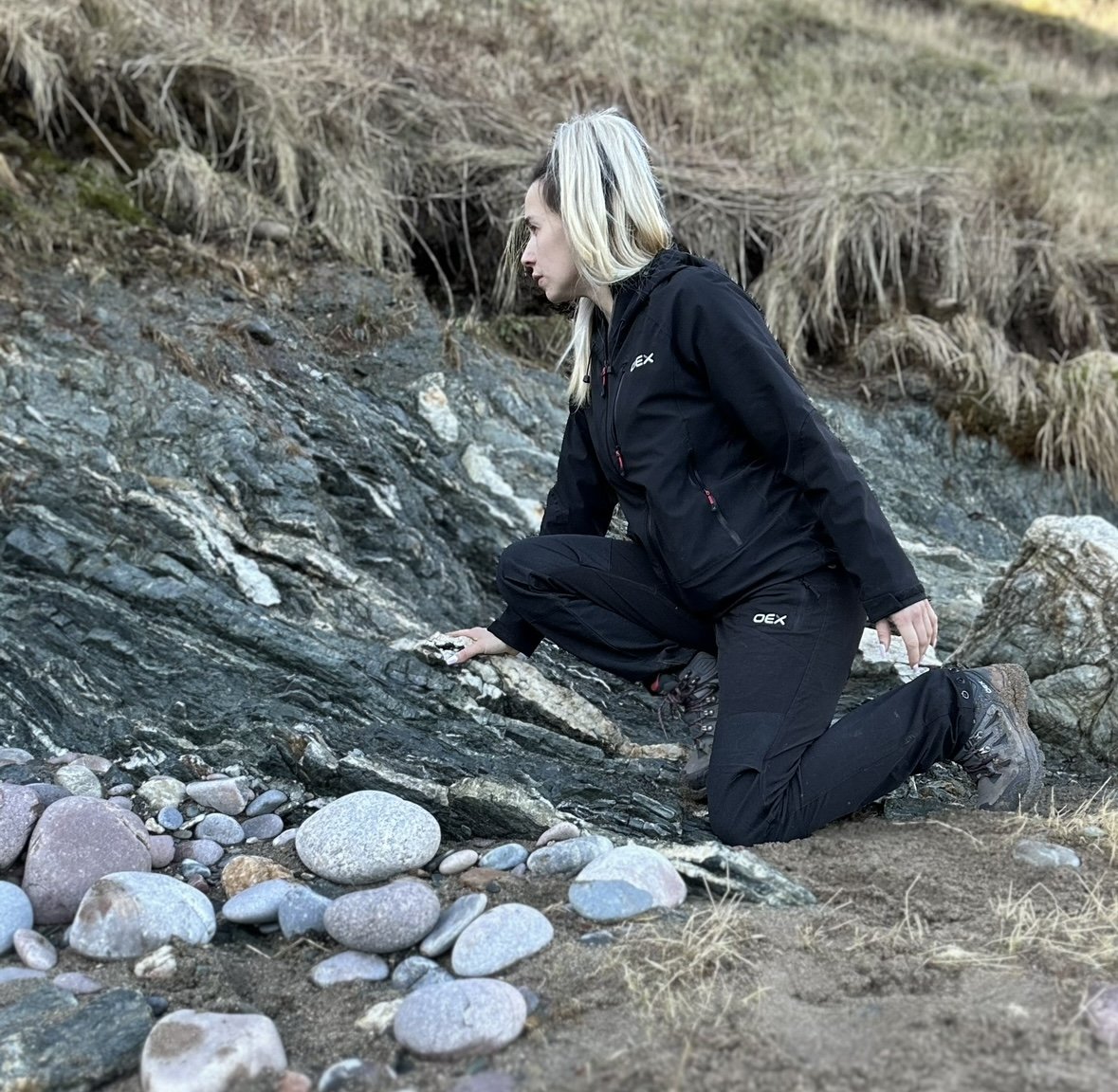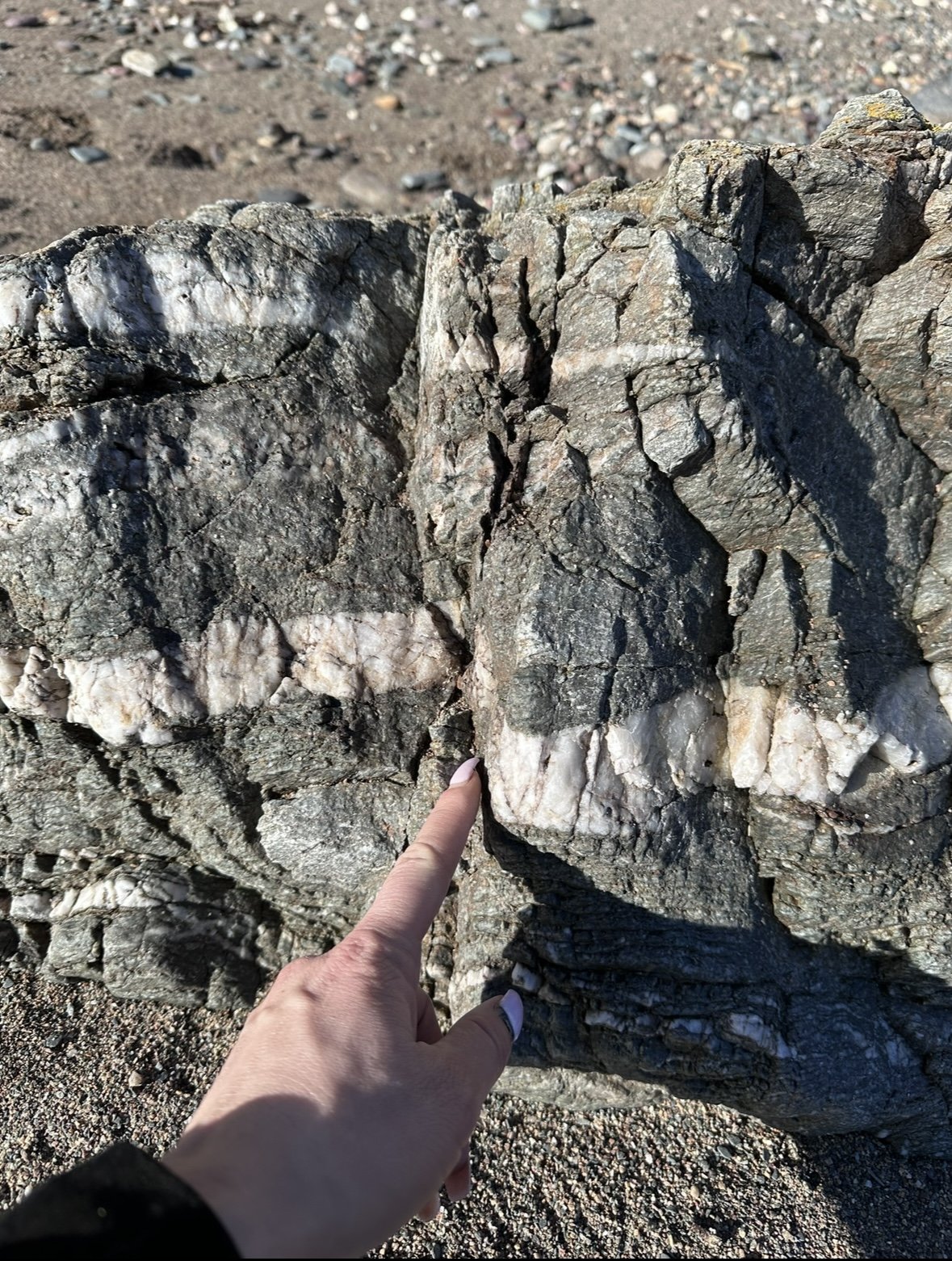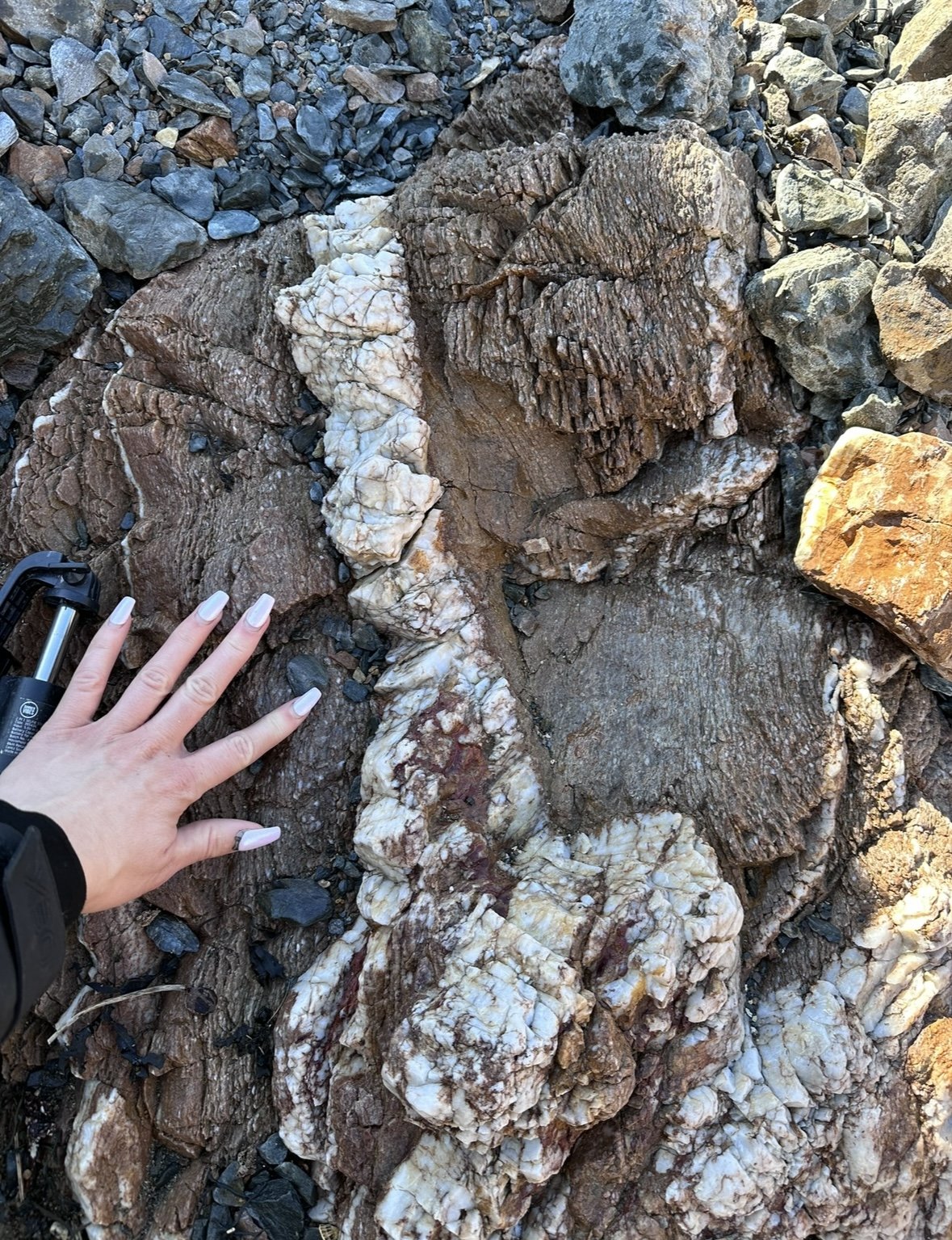The geology of Arbroath and Stonehaven - Sunday 8th December 2024
Stonehaven and Arbroath offer a fascinating journey through Scotland’s ancient geological past. These locations are famous for their diverse rock formations, unique coastal features, and the role they played in shaping our understanding of Earth’s history, particularly the development of modern geology.
The bus will leave Glasgow city centre at 8:30. Meeting time will be outside Costa Coffee, 50 George Square, Glasgow, G2 1EH.
Arbroath
Arbroath Cliffs: A highlight of the tour would be the walk along the Arbroath cliffs. The red sandstone cliffs here, part of the Old Red Sandstone, contain fossilized remains of fish and early land plants, indicating the region’s importance for paleontological studies. The geologist could point out sedimentary layers that tell the story of changing environments millions of years ago.
Learn about the transition between different sedimentary environments over millions of years.
Learn about erosion processes that shaped the distinctive cliffs and sea stacks, which are among the finest examples of natural erosion in Scotland.
Learn about the old red sandstone formation and sedimentary rocks
You can join us for this trip for £20 - meeting point will be at the following locality at 10:30. Tour will last 1.5 hours between 10:30 to 12:00
Travel to Stonehaven 12:00 to 13:00.
Stonehaven
One of the most significant geological features in Scotland cuts right through Stonehaven - the Highland Boundary Fault. This fault marks the division between the Highlands and the Lowlands of Scotland.
Learn all about the highland boundary fault lines formation
Learn about the meta sedimentary rocks that represent the central highlands Terrane
Learn about the old red sandstone of the midland valley Terrane (the lowlands)
You can join us on this tour and meet us at the following locality at 13:00. Tour will last 1.5 house between 13:00 to 14:30.
Pricing / ticket options
If you’d only like to attend one trip this is £20.00
If you’d like to join both and meet at both localities using your own transport for Arbroath and Stonehaven - this is £37.50
If you’d like a day ticket Which includes transport from and to Glasgow city centre this is £65.00
Return to Glasgow will be around 17:30ish
Associated Risks
There are a few potential risks associated with this type of tour, which would be highlighted by the guide to ensure safety:
1. Cliffside Hazards: Both Stonehaven and Arbroath are coastal locations with high cliffs, and the primary risk would be falls or injuries caused by loose rocks. Visitors would need to stay clear of cliff edges, and extra caution should be exercised in wet or windy conditions, which can make paths slippery.
2. Tidal Hazards: Some areas of the coastline are only accessible at low tide, thus will be planned in and accessed on the day to avoid incoming tides that could trap visitors in vulnerable areas. An understanding of the local tidal patterns is essential to minimize this risk.
3. Erosion and Rockfall: Coastal erosion is a natural process, and rockfalls can occur without warning. Visitors would need to be aware of signs of unstable cliffs or recent rockfall activity, and the geologist would point out areas to avoid.
4. Weather Conditions: Scotland’s weather can be unpredictable, with sudden changes that could pose risks of hypothermia or heat exhaustion, depending on the season. Participants should be advised to wear appropriate clothing and footwear, as well as bring supplies such as water and sun protection. Please wrap up as this tour will be held in December.
5. Slippery Surfaces: The coastal terrain includes rocky areas and beaches that can be slick with algae or sea spray. Caution must be taken when walking over such surfaces to avoid slips and falls.
Stonehaven and Arbroath offer a fascinating journey through Scotland’s ancient geological past. These locations are famous for their diverse rock formations, unique coastal features, and the role they played in shaping our understanding of Earth’s history, particularly the development of modern geology.
The bus will leave Glasgow city centre at 8:30. Meeting time will be outside Costa Coffee, 50 George Square, Glasgow, G2 1EH.
Arbroath
Arbroath Cliffs: A highlight of the tour would be the walk along the Arbroath cliffs. The red sandstone cliffs here, part of the Old Red Sandstone, contain fossilized remains of fish and early land plants, indicating the region’s importance for paleontological studies. The geologist could point out sedimentary layers that tell the story of changing environments millions of years ago.
Learn about the transition between different sedimentary environments over millions of years.
Learn about erosion processes that shaped the distinctive cliffs and sea stacks, which are among the finest examples of natural erosion in Scotland.
Learn about the old red sandstone formation and sedimentary rocks
You can join us for this trip for £20 - meeting point will be at the following locality at 10:30. Tour will last 1.5 hours between 10:30 to 12:00
Travel to Stonehaven 12:00 to 13:00.
Stonehaven
One of the most significant geological features in Scotland cuts right through Stonehaven - the Highland Boundary Fault. This fault marks the division between the Highlands and the Lowlands of Scotland.
Learn all about the highland boundary fault lines formation
Learn about the meta sedimentary rocks that represent the central highlands Terrane
Learn about the old red sandstone of the midland valley Terrane (the lowlands)
You can join us on this tour and meet us at the following locality at 13:00. Tour will last 1.5 house between 13:00 to 14:30.
Pricing / ticket options
If you’d only like to attend one trip this is £20.00
If you’d like to join both and meet at both localities using your own transport for Arbroath and Stonehaven - this is £37.50
If you’d like a day ticket Which includes transport from and to Glasgow city centre this is £65.00
Return to Glasgow will be around 17:30ish
Associated Risks
There are a few potential risks associated with this type of tour, which would be highlighted by the guide to ensure safety:
1. Cliffside Hazards: Both Stonehaven and Arbroath are coastal locations with high cliffs, and the primary risk would be falls or injuries caused by loose rocks. Visitors would need to stay clear of cliff edges, and extra caution should be exercised in wet or windy conditions, which can make paths slippery.
2. Tidal Hazards: Some areas of the coastline are only accessible at low tide, thus will be planned in and accessed on the day to avoid incoming tides that could trap visitors in vulnerable areas. An understanding of the local tidal patterns is essential to minimize this risk.
3. Erosion and Rockfall: Coastal erosion is a natural process, and rockfalls can occur without warning. Visitors would need to be aware of signs of unstable cliffs or recent rockfall activity, and the geologist would point out areas to avoid.
4. Weather Conditions: Scotland’s weather can be unpredictable, with sudden changes that could pose risks of hypothermia or heat exhaustion, depending on the season. Participants should be advised to wear appropriate clothing and footwear, as well as bring supplies such as water and sun protection. Please wrap up as this tour will be held in December.
5. Slippery Surfaces: The coastal terrain includes rocky areas and beaches that can be slick with algae or sea spray. Caution must be taken when walking over such surfaces to avoid slips and falls.
Stonehaven and Arbroath offer a fascinating journey through Scotland’s ancient geological past. These locations are famous for their diverse rock formations, unique coastal features, and the role they played in shaping our understanding of Earth’s history, particularly the development of modern geology.
The bus will leave Glasgow city centre at 8:30. Meeting time will be outside Costa Coffee, 50 George Square, Glasgow, G2 1EH.
Arbroath
Arbroath Cliffs: A highlight of the tour would be the walk along the Arbroath cliffs. The red sandstone cliffs here, part of the Old Red Sandstone, contain fossilized remains of fish and early land plants, indicating the region’s importance for paleontological studies. The geologist could point out sedimentary layers that tell the story of changing environments millions of years ago.
Learn about the transition between different sedimentary environments over millions of years.
Learn about erosion processes that shaped the distinctive cliffs and sea stacks, which are among the finest examples of natural erosion in Scotland.
Learn about the old red sandstone formation and sedimentary rocks
You can join us for this trip for £20 - meeting point will be at the following locality at 10:30. Tour will last 1.5 hours between 10:30 to 12:00
Travel to Stonehaven 12:00 to 13:00.
Stonehaven
One of the most significant geological features in Scotland cuts right through Stonehaven - the Highland Boundary Fault. This fault marks the division between the Highlands and the Lowlands of Scotland.
Learn all about the highland boundary fault lines formation
Learn about the meta sedimentary rocks that represent the central highlands Terrane
Learn about the old red sandstone of the midland valley Terrane (the lowlands)
You can join us on this tour and meet us at the following locality at 13:00. Tour will last 1.5 house between 13:00 to 14:30.
Pricing / ticket options
If you’d only like to attend one trip this is £20.00
If you’d like to join both and meet at both localities using your own transport for Arbroath and Stonehaven - this is £37.50
If you’d like a day ticket Which includes transport from and to Glasgow city centre this is £65.00
Return to Glasgow will be around 17:30ish
Associated Risks
There are a few potential risks associated with this type of tour, which would be highlighted by the guide to ensure safety:
1. Cliffside Hazards: Both Stonehaven and Arbroath are coastal locations with high cliffs, and the primary risk would be falls or injuries caused by loose rocks. Visitors would need to stay clear of cliff edges, and extra caution should be exercised in wet or windy conditions, which can make paths slippery.
2. Tidal Hazards: Some areas of the coastline are only accessible at low tide, thus will be planned in and accessed on the day to avoid incoming tides that could trap visitors in vulnerable areas. An understanding of the local tidal patterns is essential to minimize this risk.
3. Erosion and Rockfall: Coastal erosion is a natural process, and rockfalls can occur without warning. Visitors would need to be aware of signs of unstable cliffs or recent rockfall activity, and the geologist would point out areas to avoid.
4. Weather Conditions: Scotland’s weather can be unpredictable, with sudden changes that could pose risks of hypothermia or heat exhaustion, depending on the season. Participants should be advised to wear appropriate clothing and footwear, as well as bring supplies such as water and sun protection. Please wrap up as this tour will be held in December.
5. Slippery Surfaces: The coastal terrain includes rocky areas and beaches that can be slick with algae or sea spray. Caution must be taken when walking over such surfaces to avoid slips and falls.





